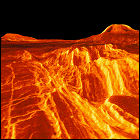 The third phase of data gathering begins for NASA’s Magellan unmanned space probe, launched via space shuttle in 1989 and currently orbiting the heavily-clouded planet Venus. Using radar to peer through the planet’s dense clouds, Magellan has now mapped 96% of the planet’s surface, and will now spend much of the remainder of 1992 filling in details in regions it has missed, as well as re-scanning some regions of Venus stereoscopically, allowing for three-dimensional terrain reconstruction.
The third phase of data gathering begins for NASA’s Magellan unmanned space probe, launched via space shuttle in 1989 and currently orbiting the heavily-clouded planet Venus. Using radar to peer through the planet’s dense clouds, Magellan has now mapped 96% of the planet’s surface, and will now spend much of the remainder of 1992 filling in details in regions it has missed, as well as re-scanning some regions of Venus stereoscopically, allowing for three-dimensional terrain reconstruction.

 NASA’s unmanned Magellan space probe, having completed three extensive campaigns of mapping the surface of Venus from orbit with cloud-penetrating radar, begins a fourth mission phase, this time sending constant engineering telemetry to Earth, where measurements of Doppler shift in the signal received allows Earthbound scientists to map the gravitational field of Venus. Magellan’s map-making days are over, having achieved a 98% complete map of the cloud-shrouded planet that it has been orbiting since 1990.
NASA’s unmanned Magellan space probe, having completed three extensive campaigns of mapping the surface of Venus from orbit with cloud-penetrating radar, begins a fourth mission phase, this time sending constant engineering telemetry to Earth, where measurements of Doppler shift in the signal received allows Earthbound scientists to map the gravitational field of Venus. Magellan’s map-making days are over, having achieved a 98% complete map of the cloud-shrouded planet that it has been orbiting since 1990.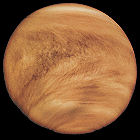 The Pioneer Venus Orbiter, launched into orbit around Venus in 1978 and now the only surviving component of the Pioneer Venus mission, enters the cloudy planet’s dense, toxic atmosphere and disintegrates, its fuel supply too exhausted to keep it in orbit any longer. Originally intended to orbit Venus for only a year, Pioneer Venus has survived, fully functional, for nearly 14 years in Venusian orbit, continuing to study the planet and taking readings not only Venus but such objects as Halley’s Comet.
The Pioneer Venus Orbiter, launched into orbit around Venus in 1978 and now the only surviving component of the Pioneer Venus mission, enters the cloudy planet’s dense, toxic atmosphere and disintegrates, its fuel supply too exhausted to keep it in orbit any longer. Originally intended to orbit Venus for only a year, Pioneer Venus has survived, fully functional, for nearly 14 years in Venusian orbit, continuing to study the planet and taking readings not only Venus but such objects as Halley’s Comet.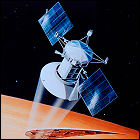 To increase the accuracy of its gravity map of the planet Venus, NASA’s unmanned space probe Magellan conducts the first experimental aerobraking maneuvers to alter the shape its orbit to a near-circular shape. By dipping Magellan into the upper layers of the Venusian atmosphere, the spacecraft is slowed and its orbit is changed, but it is kept far enough from the denser lower layers of the atmosphere to avoid re-entry. Aerobraking will become more commonly used by future space probes at the planet Mars.
To increase the accuracy of its gravity map of the planet Venus, NASA’s unmanned space probe Magellan conducts the first experimental aerobraking maneuvers to alter the shape its orbit to a near-circular shape. By dipping Magellan into the upper layers of the Venusian atmosphere, the spacecraft is slowed and its orbit is changed, but it is kept far enough from the denser lower layers of the atmosphere to avoid re-entry. Aerobraking will become more commonly used by future space probes at the planet Mars.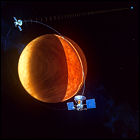 NASA’s Magellan space probe, still orbiting Venus since 1990, enters a phase of slightly riskier experiments, dipping its solar panels into the upper reaches of the Venusian atmosphere and firing its reaction control engines to keep from spinning out of control. This allows for studies of the composition of Venus’ atmosphere, as well as studies of the vehicle’s behavior as it resists atmospheric friction. The results of the “windmill” experiment inform the design of future Mars probes which will need to aerobrake to slow down and enter the Martian atmosphere.
NASA’s Magellan space probe, still orbiting Venus since 1990, enters a phase of slightly riskier experiments, dipping its solar panels into the upper reaches of the Venusian atmosphere and firing its reaction control engines to keep from spinning out of control. This allows for studies of the composition of Venus’ atmosphere, as well as studies of the vehicle’s behavior as it resists atmospheric friction. The results of the “windmill” experiment inform the design of future Mars probes which will need to aerobrake to slow down and enter the Martian atmosphere.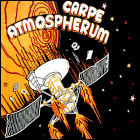 NASA’s Magellan space probe, orbiting Venus since 1990, is retired by entering the atmosphere of the planet whose surface it has mapped. With its power systems exhibiting signs of age and wear, Magellan has been intentionally dropped into an orbit low enough to allow its destruction in Venus’ dense atmosphere. Launched in 1989 via space shuttle, Magellan mapped the planet’s surface with cloud-penetrating radar, covering 98% of the Venusian surface, at least 1/5 of it with stereoscopic imaging allowing for accurate 3-D reconstruction of Venus’ surface features.
NASA’s Magellan space probe, orbiting Venus since 1990, is retired by entering the atmosphere of the planet whose surface it has mapped. With its power systems exhibiting signs of age and wear, Magellan has been intentionally dropped into an orbit low enough to allow its destruction in Venus’ dense atmosphere. Launched in 1989 via space shuttle, Magellan mapped the planet’s surface with cloud-penetrating radar, covering 98% of the Venusian surface, at least 1/5 of it with stereoscopic imaging allowing for accurate 3-D reconstruction of Venus’ surface features.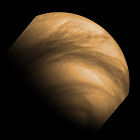 The European Space Agency’s Venus Express space probe – the first unmanned spacecraft to closely examine the second planet from the sun since the late 1970s – arrives at the planet to undertake a detailed study of the atmosphere, the unusually symmetrical cloud patterns of the planet’s north and south hemispheres, as well as observing the massive, hurricane-like vortices which remain over the poles. Venus Express also looks for the source of traces of sulphur dioxide in the Venusian atmosphere, which could be a sign that of active volcanoes on the surface.
The European Space Agency’s Venus Express space probe – the first unmanned spacecraft to closely examine the second planet from the sun since the late 1970s – arrives at the planet to undertake a detailed study of the atmosphere, the unusually symmetrical cloud patterns of the planet’s north and south hemispheres, as well as observing the massive, hurricane-like vortices which remain over the poles. Venus Express also looks for the source of traces of sulphur dioxide in the Venusian atmosphere, which could be a sign that of active volcanoes on the surface.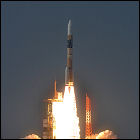 The Japanese space agency, JAXA, launches unmanned space probe AKATSUKI, known more formally as the Venus Climate Orbiter. The spacecraft is expected to reach Venus in seven months and take up orbit around that planet, where it will study Venus’ atmosphere in depth. “Akatsuki” translates to “Dawn”, but is referred to by its Japanese name to avoid confusion with NASA’s asteroid-belt-exploring Dawn spacecraft.
The Japanese space agency, JAXA, launches unmanned space probe AKATSUKI, known more formally as the Venus Climate Orbiter. The spacecraft is expected to reach Venus in seven months and take up orbit around that planet, where it will study Venus’ atmosphere in depth. “Akatsuki” translates to “Dawn”, but is referred to by its Japanese name to avoid confusion with NASA’s asteroid-belt-exploring Dawn spacecraft.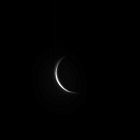 Japan’s AKATSUKI unmanned space probe fires its thrusters to slow down enough to be captured into an orbit around Venus, a maneuver which will take place mostly in the planet’s shadow, out of communication with Earth. But when ground controllers reacquire communications with AKATSUKI, it is in safe mode, and not in its predicted orbit around Venus. The main orbital engine, damaged by overheating due to salt deposits on a fuel valve, fired for less than three minutes and cannot safely be fired again, leaving AKATSUKI into a solar orbit. Mission planners put AKATSUKI into a hibernation mode to preserve it for another opportunity to orbit Venus in 2015.
Japan’s AKATSUKI unmanned space probe fires its thrusters to slow down enough to be captured into an orbit around Venus, a maneuver which will take place mostly in the planet’s shadow, out of communication with Earth. But when ground controllers reacquire communications with AKATSUKI, it is in safe mode, and not in its predicted orbit around Venus. The main orbital engine, damaged by overheating due to salt deposits on a fuel valve, fired for less than three minutes and cannot safely be fired again, leaving AKATSUKI into a solar orbit. Mission planners put AKATSUKI into a hibernation mode to preserve it for another opportunity to orbit Venus in 2015.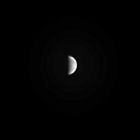 JAXA, the Japanese space agency, announces its plans to put the unmanned AKATSUKI space probe into orbit around Venus. Originally launched in 2010, AKATSUKI failed to orbit the planet in December of that year due to a critical engine malfunction and instead fell into an orbit around the sun, but mission planners have devised a strategy to use its attitude control engines to slow it enough to be captured around Venus when it intersects the planet’s orbit again. AKATSUKI, more formally known as the Venus Climate Orbiter, is intended to study the atmosphere and weather of Venus, a mission it will begin in December if it can successfully enter orbit.
JAXA, the Japanese space agency, announces its plans to put the unmanned AKATSUKI space probe into orbit around Venus. Originally launched in 2010, AKATSUKI failed to orbit the planet in December of that year due to a critical engine malfunction and instead fell into an orbit around the sun, but mission planners have devised a strategy to use its attitude control engines to slow it enough to be captured around Venus when it intersects the planet’s orbit again. AKATSUKI, more formally known as the Venus Climate Orbiter, is intended to study the atmosphere and weather of Venus, a mission it will begin in December if it can successfully enter orbit.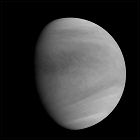 The Japanese space probe AKATSUKI, launched in 2010 but left in an orbit around the sun by an engine glitch, catches up with its original target, the planet Venus, and fires its attitude control thrusters. The lengthy engine burn slows AKATSUKI enough to be captured by Venus’ gravity, in an elliptical 13-day orbit that brings the probe within 250 miles of the Venusian clouds it was sent to study at its closest, and nearly a quarter million miles away from the planet at the furthest. Another engine burn is planned for March 2016 to circularize and shorten AKATSUKI’s orbit so it can begin its observations of the planet’s weather patterns.
The Japanese space probe AKATSUKI, launched in 2010 but left in an orbit around the sun by an engine glitch, catches up with its original target, the planet Venus, and fires its attitude control thrusters. The lengthy engine burn slows AKATSUKI enough to be captured by Venus’ gravity, in an elliptical 13-day orbit that brings the probe within 250 miles of the Venusian clouds it was sent to study at its closest, and nearly a quarter million miles away from the planet at the furthest. Another engine burn is planned for March 2016 to circularize and shorten AKATSUKI’s orbit so it can begin its observations of the planet’s weather patterns.